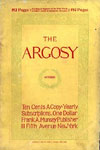Western Story Magazine
On July 12, 1919, the first all-western pulp, Street & Smith's Western Story Magazine, arrived on newsstands. Dated September 5th, and priced at $.10, the inaugural issue promised quality entertainment with "Big Clean Stories of Outdoor Life." For the next thirty years, Western Story passed under the pens of three editors (Frank Blackwell [1919-34], Dorothy Hubbard [1934-7], and John Burr [1937-49]), yet always maintained its initial editorial commitment to clean, quality westerns.
Street & Smith's business manager, Henry Ralston, initially viewed Western Story Magazine as the unavoidable burden of his inability to sell the once successful New Buffalo Bill Weekly. The weekly began in 1912 as the second generation of the dime novel series, Buffalo Bill Stories; however, after the death of the real "Buffalo Bill" Cody in 1917, interest in the weekly began to fade. Unable to find a buyer for the failing title, Ralston committed himself to revitalizing the publication and attempting to imitate the success of Street & Smith's Detective Story Magazine, which had appeared in 1916 as one of the first single-genre pulps.
With the help of Frank Blackwell, Ralston reformed the weekly into a focused, quality collection of "rapidly moving stories of the west" (1001, 30). Within this prototype for future western pulps, Ralston and Blackwell printed an array of fiction, as well as eight different features, such as the editor's "Round Up" and "The Hollow Tree," a forum for missing persons' reports. Additionally, Ralston and Blackwell preserved ties to the magazine's former manifestation, featuring stories about "Buffalo Bill" throughout the remainder of 1919.
Hundreds of authors contributed to Western Story Magazine during its thirty-year run, but none were so prolific or dedicated as Frederick Faust, a.k.a. Max Brand. The first installment of Faust's "Jerry Peyton's Notched Inheritance" appeared in Western Story on November 15, 1920. For the next twelve years, one could often find up to three Faust stories in a single issue of the magazine (March 12, 1932; April 2, 1932); each published under a different pen name, including his Western Story specific alias, George Owen Baxter.
Along with Faust's many identities, Western Story featured the work of William MacLeod Raine, Jackson Gregory, Bertrand W. Sinclair, and Ernest Haycox. Spurred on by its impressive roster of contributors, Western Story's circulation reached almost two million readers by 1922. According to Jon Tuska, Street & Smith was earning approximately $400,000 on a single issue of Western Story during this period.
Near the end of the 1920s and into the 1930s, Western Story Magazine would receive competition from newer, more violent western pulps, such as Lariat Story Magazine, West, and Wild West Weekly. Compared with these titles, Western Story's commitment to the honorable cowboys and the wide, open prairies seemed old-fashioned. In 1932, the publishers lowered the price of the magazine from $.15 to $.10, but Western Story never again reached the level of economic success of the mid-twenties. In 1944, Western Story scaled back its weekly publication schedule and began appearing just once a month. Five years later, in 1949, after running for a total of 1,263 issues, Western Story Magazine finally folded.
Alexandra Yancey, The University of Tulsa
Works Cited and Consulted
1001 Places to Sell Manuscripts: A Complete Guide for all Writers who are Seeking Avenues for the Publication of Original Manuscripts. 10th edition. Franklin, OH: James Knapp Reeve, 1921.
Dinan, John A. The Pulp Western. No. 2, I.O. Evans Studies in the Philosophy and Criticism of Literature. San Bernardino, CA: The Borgo Press, 1983.
Tuska, Jon. The Western Story: A Chronological Treasury. Lincoln: University of Nebraska Press, 1999.





